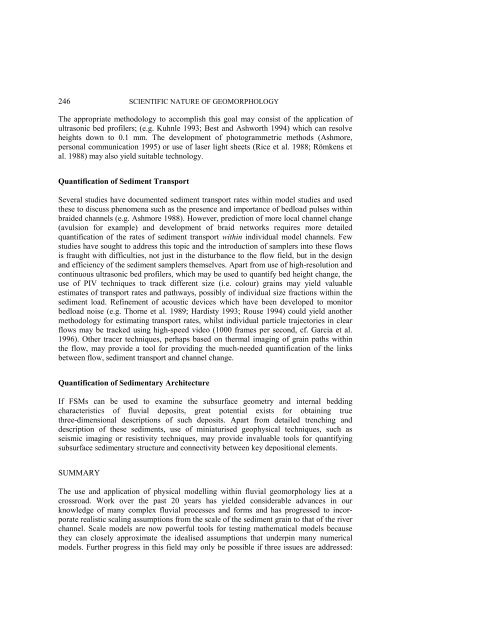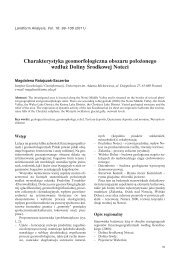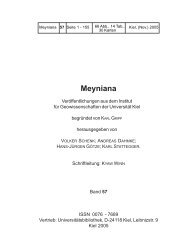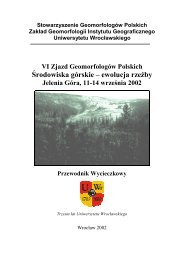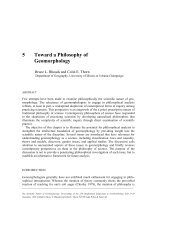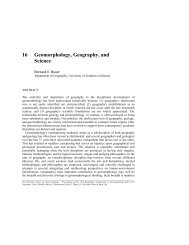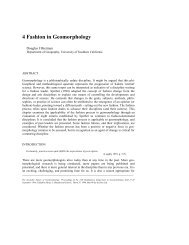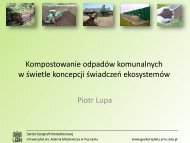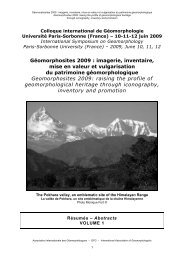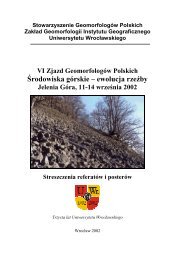Physical Modelling in Fluvial Geomorphology
Physical Modelling in Fluvial Geomorphology
Physical Modelling in Fluvial Geomorphology
You also want an ePaper? Increase the reach of your titles
YUMPU automatically turns print PDFs into web optimized ePapers that Google loves.
246 SCIENTIFIC NATURE OF GEOMORPHOLOGY<br />
The appropriate methodology to accomplish this goal may consist of the application of<br />
ultrasonic bed profilers; (e.g. Kuhnle 1993; Best and Ashworth 1994) which can resolve<br />
heights down to 0.1 mm. The development of photogrammetric methods (Ashmore,<br />
personal communication 1995) or use of laser light sheets (Rice et al. 1988; Römkens et<br />
al. 1988) may also yield suitable technology.<br />
Quantification of Sediment Transport<br />
Several studies have documented sediment transport rates with<strong>in</strong> model studies and used<br />
these to discuss phenomena such as the presence and importance of bedload pulses with<strong>in</strong><br />
braided channels (e.g. Ashmore 1988). However, prediction of more local channel change<br />
(avulsion for example) and development of braid networks requires more detailed<br />
quantification of the rates of sediment transport with<strong>in</strong> <strong>in</strong>dividual model channels. Few<br />
studies have sought to address this topic and the <strong>in</strong>troduction of samplers <strong>in</strong>to these flows<br />
is fraught with difficulties, not just <strong>in</strong> the disturbance to the flow field, but <strong>in</strong> the design<br />
and efficiency of the sediment samplers themselves. Apart from use of high-resolution and<br />
cont<strong>in</strong>uous ultrasonic bed profilers, which may be used to quantify bed height change, the<br />
use of PIV techniques to track different size (i.e. colour) gra<strong>in</strong>s may yield valuable<br />
estimates of transport rates and pathways, possibly of <strong>in</strong>dividual size fractions with<strong>in</strong> the<br />
sediment load. Ref<strong>in</strong>ement of acoustic devices which have been developed to monitor<br />
bedload noise (e.g. Thorne et al. 1989; Hardisty 1993; Rouse 1994) could yield another<br />
methodology for estimat<strong>in</strong>g transport rates, whilst <strong>in</strong>dividual particle trajectories <strong>in</strong> clear<br />
flows may be tracked us<strong>in</strong>g high-speed video (1000 frames per second, cf. Garcia et al.<br />
1996). Other tracer techniques, perhaps based on thermal imag<strong>in</strong>g of gra<strong>in</strong> paths with<strong>in</strong><br />
the flow, may provide a tool for provid<strong>in</strong>g the much-needed quantification of the l<strong>in</strong>ks<br />
between flow, sediment transport and channel change.<br />
Quantification of Sedimentary Architecture<br />
If FSMs can be used to exam<strong>in</strong>e the subsurface geometry and <strong>in</strong>ternal bedd<strong>in</strong>g<br />
characteristics of fluvial deposits, great potential exists for obta<strong>in</strong><strong>in</strong>g true<br />
three-dimensional descriptions of such deposits. Apart from detailed trench<strong>in</strong>g and<br />
description of these sediments, use of m<strong>in</strong>iaturised geophysical techniques, such as<br />
seismic imag<strong>in</strong>g or resistivity techniques, may provide <strong>in</strong>valuable tools for quantify<strong>in</strong>g<br />
subsurface sedimentary structure and connectivity between key depositional elements.<br />
SUMMARY<br />
The use and application of physical modell<strong>in</strong>g with<strong>in</strong> fluvial geomorphology lies at a<br />
crossroad. Work over the past 20 years has yielded considerable advances <strong>in</strong> our<br />
knowledge of many complex fluvial processes and forms and has progressed to <strong>in</strong>corporate<br />
realistic scal<strong>in</strong>g assumptions from the scale of the sediment gra<strong>in</strong> to that of the river<br />
channel. Scale models are now powerful tools for test<strong>in</strong>g mathematical models because<br />
they can closely approximate the idealised assumptions that underp<strong>in</strong> many numerical<br />
models. Further progress <strong>in</strong> this field may only be possible if three issues are addressed:


